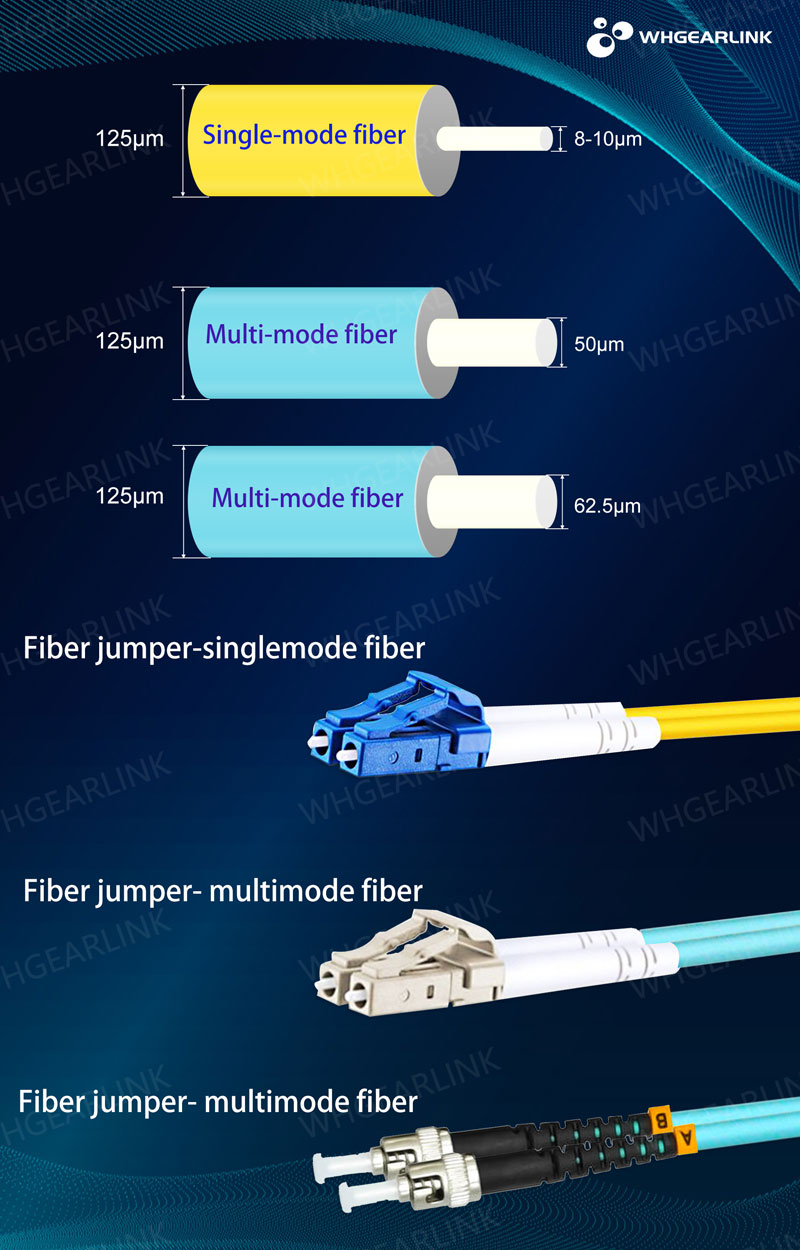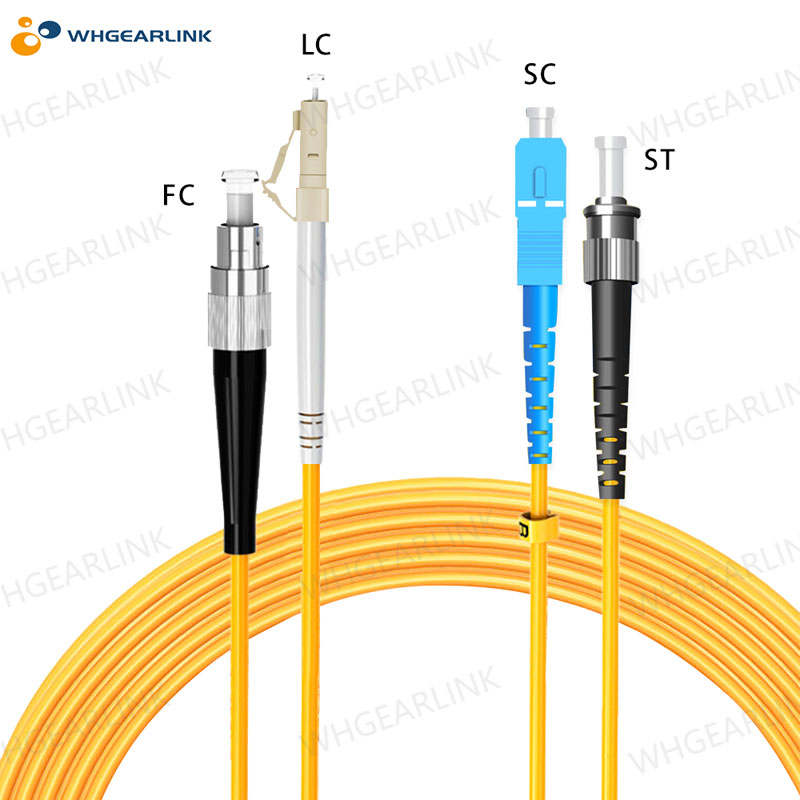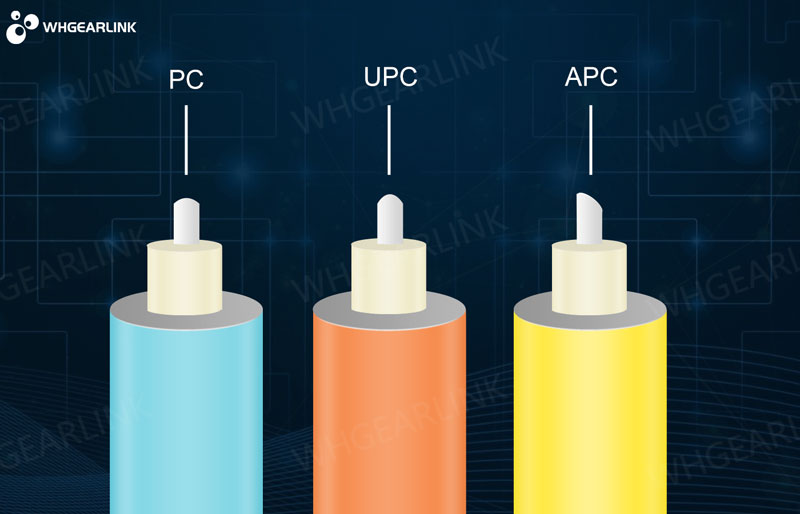Optical fiber is a flexible and transparent fiber made up of glass (silica) or plastic, which transmit information from one end of the fiber to another.
Classified by mode:
①Single-mode fiber: with yellow jumper and blue connector.
②Multi-mode fiber: the jumper of OM1 and OM2 is orange and OM3 & OM4 jumpers is light green, connector is beige or black.
Classified by connector: Four commonly used types are LC, SC, FC, ST.
①LC optical fiber jumper: Normally connected with SFP optical transceivers and used for routers, easily operate.
②SC optical fiber jumper: It is rectangular outer shell and adopted the plug-in pin latch type which has small fluctuation in access loss. Mostly connected with GBIC optical transceivers and used for routers& switches.
③FC optical fiber jumper: It is with metal outer cover and turnbuckle type which has strong tightness and dust resistance, mostly used for distribution frame.
④ST optical fiber jumper: It is a round outer shell and turnbuckle type, but the core is exposed. Mostly used for distribution frame.
Classified by application: Divided into MTP/MPO, armored and conventional fiber optic jumpers.
①MTP/MPO fiber jumper: It's push-pull locking which is convenient to install and remove, save your time and money. Mostly used for structured cabling and high-density integration line.
②Armored optical fiber: It's moisture-proof, fire-proof, anti-static, acid and alkali resistance meanwhile no need protective casing. Mostly used in the computer room or harsh environments.
③Conventional optic fiber: It has strong scalability, compatibility and interoperability compared with MTP/MPO and armored optic fiber, which has low cost.

1>The grinding method is the cross-section craft of optical fiber connector such as PC/UPC, APC.
PC (Physical Contact) is micro-spherical grinding and polishing on the surface;
UPC (Ultra Physical Contact) optimizes the polishing of the end face on the basis of PC, and looks more dome-shaped;
APC (Angled Physical Contact) refers to the physical contact of the inclined surface. The fiber end face is usually polished to an 8° bevel.
2>Differences.
①Color: Typically APC connector is green and UPC/PC is blue;
②Insertion loss: They are all should be less than 0.3dB. But compared with APC connectors, UPC/PC connectors are easier to achieve low insertion loss due to the smaller air gap,
③Return loss(reflection loss): Expressed by negative dB, the higher of the parameter, the better. Generally the return loss of fiber jumper in the PC grinding mode is -40dB, UPC is -55dB and APC is -60dB. Therefore return loss of the APC connector is better than UPC and PC.
④ Application: PC is the most common grinding method and widely used for telecom operator; UPC is used for Ethernet network digital and cable television etc; APC is used in optical RF applications as well passive applications such as PON network or passive optical LAN.
APC cannot be connected with UPC due to the cross-section which is an angle of 8 degrees. However, PC and UPC are both flat and can be mixed connected.

①Diameter
Single-mode fiber: The core diameter is 8-10µm and cladding diameter is 125 µm;
Multi-mode fiber: The core diameter is 50 or 62.5µm and cladding diameter is 125µm.
②Color:
Single-mode fiber: The color of optic fiber is yellow and connector & protective cover are blue;
Multi-mode fiber: The color of optic fiber is light green and connector & protective cover are beige or black.
③Light source:
Single-mode fiber uses laser to produce a single wavelength of light which has greater light-gathering capacity than LED used by multi-mode fiber.
④ Modal dispersion:
Single-mode fiber has a smaller modal dispersion and longer transmission distance than multi-mode fiber due to the light source.
⑤Bandwidth:
Single-mode fiber has a higher bandwidth than multi-mode fiber due to the larger core size of multi-mode fiber.
⑥Cost:
The price of single-mode fiber is lower than multi-mode fiber, but the equipment is more expensive than that of multi-mode fiber, therefore the cost is higher than dual-mode fiber.
⑦Transmission distance:
The transmission distance of multi-mode optical fiber is up to 2km while single-mode fiber can reach at least 5km.

1>Type: Simplex or duplex fiber optic(single fiber or dual fiber)
Simplex means there is only one fiber and one connector at each end, which is used for bidirectional (BIDI) optical transceivers. Duplex can be seen as two fiber jumpers side by side, used for ordinary optical transceivers.
2>Cable outer sheath material:
It can be divided into 4 types: ordinary, ordinary flame-retardant, low-smoke halogen-free(LZSH) and low-smoke halogen-free flame-retardant type, etc.
3>Length:
The length of fiber jumper is different such as1m, 5m, 10m, 20m, 30m, and 50m, which can be selected according to the distance between the devices.

